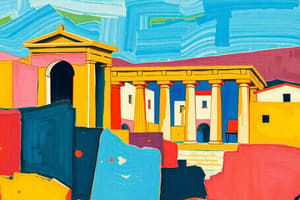Podcast
Questions and Answers
What caused the abandonment of the city of Ai-Khanoum?
What caused the abandonment of the city of Ai-Khanoum?
- Seleucid–Mauryan war
- Saka tribes invasions (correct)
- Soviet-Afghan War
- A fire
What was the city of Ai-Khanoum built near?
What was the city of Ai-Khanoum built near?
- The banks of the Oxus and Kokcha rivers (correct)
- The ruins of an old temple
- The foothills of a mountain
- The edge of a desert
What was the purpose of the city of Ai-Khanoum?
What was the purpose of the city of Ai-Khanoum?
- To serve as a military and economic centre (correct)
- To be a major center of Hellenistic culture
- To provide a home for the Saka tribes
- To be a strategic port
Who founded the city of Ai-Khanoum?
Who founded the city of Ai-Khanoum?
What was the natural protection of the city of Ai-Khanoum?
What was the natural protection of the city of Ai-Khanoum?
Flashcards are hidden until you start studying
Study Notes
-
The city was founded by an early ruler of the Seleucid Empire.
-
The city served as a military and economic centre for the rulers of the Greco-Bactrian Kingdom until its destruction c. 145 BC.
-
The ruins of the city were excavated by a French team of archaeologists until the onset of conflict in Afghanistan in the late 1970s.
-
Hellenistic culture in the region would persist longer only in the Indo-Greek kingdoms.
-
The onset of the Soviet-Afghan War in the late 1970s halted scholarly progress, and during the following conflicts in Afghanistan, the site was extensively looted.
-
After the Seleucid–Mauryan war, Seleucus ceded the Indus Valley to Chandragupta Maurya, in return for a pact of friendship and 500 war elephants; he thus sought the sustained economic and military development of Bactria, which was now the headquarters of the Seleucids in the East.
-
Under his successor Antiochus II, who came to the throne in 261 BC, the mint continued to strike valuable coins, and the ramparts were bolstered with a buttress and brick linings.
-
The city's development was greatly slowed when Diodotus I, governor of the eastern provinces, seceded from the Seleucids and founded the Greco-Bactrian Kingdom.
-
Although Ai-Khanoum's temple and sanctuary were reconstructed under Diodotus, possibly to enhance religious legitimacy, most Seleucid construction programmes were not continued.
-
Bertille Lyonnet theorizes that during this time Ai-Khanoum was merely "a military stronghold with administrative functions".
-
Ai-Khanoum was an ancient city in what is now Afghanistan
-
The city was abandoned by its inhabitants in the 2nd century AD
-
In 1961, the city was rediscovered by the King of Afghanistan and the French Archaeological Delegation
-
The excavation was led by Daniel Schlumberger and then by Paul Bernard
-
The excavation revealed that the city was abandoned in the 2nd century AD and that its inhabitants were probably Saka tribes
-
The excavation also revealed that the city was once a major center of Hellenistic culture
-
The abandonment of the city was probably due to invasions by Saka tribes and a fire
-
The city of Ai-Khanoum was founded on the southwest corner of a triangular plain in the region of Bactria.
-
The plain was naturally suitable for agriculture and the city was built near the banks of the Oxus and Kokcha rivers.
-
The city was strategically important and its founders built it to a high defensive standard.
-
There were mines on the upper Kokcha in Badakshan which were the only sources of lapis lazuli in the world.
-
The city was protected by a natural acropolis, a small citadel, and cliffs on two sides.
-
Eastward approaches to the city were protected by a natural acropolis.
Studying That Suits You
Use AI to generate personalized quizzes and flashcards to suit your learning preferences.




